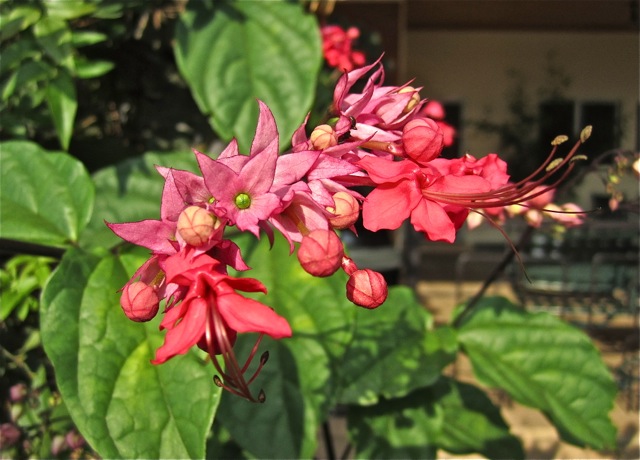In a comment, Diana of Elephant’s Eye asked me about Rwandan native plants. I had to say that I wasn’t sure how many, if any, of the plants in my garden are native to this country or region. It’s amazing how many common ornamental plants in East African gardens are of South American or Asian origin, brought here by colonists or other travelers.
Other plants originate from north, west, or southern Africa, but may have traveled to Rwanda via sojourns in European collectors’ conservatories.
To help me work it all out, I just bought The Illustrated Field Guide to the Plants of Nyungwe National Park which covers, with color photos, 650 species native to Rwanda.
It has already helped me identify two flowering vines in the garden that were unfamiliar to me, Clerodendron thomsoniae and Clerodendron thomsoniae var. delectum. They also go by the common names of Beauty Bush, Bleeding Glory-Bower, or Bleeding Heart Vine.


I found that the species is native to tropical West Africa, from Cameroon to Senegal. But a very similar-looking cousin, Clerodendron fuscum, is native to Rwanda and other parts of East Africa — as are two much less showy species, C. johnstonii and C. bukobense.
They are all lianas — long-stemmed, woody vines that use trees as a means of vertical support to reach the light.

Clerodendron thomsoniae has just the sort of exotic, showy blooms that would have been very desirable to the Victorians. Wikipedia said its 19th century popularity eventually declined, however, because “its root system must be partially submerged in water most of the time and it wants very good light.” Other sources did not indicate that it needs to grow in particularly damp ground. Mine does not. But in the U.S., it probably will not be hardy outside of Florida or California.
Wikipedia also said the species was named in honor of “Rev. William Cooper Thomson (fl. 1820’s-1880’s), a missionary and physician in Nigeria.” However, a further Google search turned up a Rev. Thomson who was a linguist, not a doctor, with the Church Missionary Society in Sierra Leone. He was a man of zeal in the propagation of the gospel and the crusade against slavery. In 1841, he led an ultimately fruitless expedition to make treaties with the Muslim Fulani people in what is now Guinea. He died during the journey in 1843.
That much is confirmed by other articles and a copy of his journal posted on the internet. There is no indication, however, of how this William Cooper Thomson might have come to have a popular hothouse plant named after him.
A French website said that the species was named for surgeon-botanist Thomas Thomson (1817-1878), co-author of the first volume of Flora Indica and eventually Superintendent of the botanical garden in Calcutta, India. Swedish Wikipedia also says that Thomas T. is origin of the name. But Thomas T. never served in Africa.
The source for the English Wikipedia entry is the CRC World Dictionary of Plant Names by Umberto Quattrocchi, which unfortunately is not on-line and costs £204. If any reader does have access to this book, maybe you could let us know what it says. Other sites also give a William Cooper Thomson. as the origin of the name, but they are obviously just quoting Wikipedia.
Regardless of the source of its name, it is really a lovely African plant.
ADDENDUM: Please see KAMCDONALD’s comment below for more about the source of the name, which was given in honor of the first wife of William Cooper Thomson, a missionary in Nigeria and son of the William Cooper T. discussed above.

My Clerodendron is just the quiet blue Oxford and Cambridge. Yours is magnificent, exotic and indigenous! And I love exploring plant names, so much history to mine.
Is yours C. ugandense (native to Uganda & Kenya) or C. glabrum (native to Southern Africa)?
Fascinating search, even if unresolved at present.
I had really hoped to discover the real Thomson.
[…] and below is a Clerodendrum thomsoniae var. delectum vine growing on plant supports in the upper bed between the two retaining walls. You can also see […]
[…] Above: To the right of the orange hibicus is a Clerondendron thomsoniae var. delectum. […]
Hello, Interesting post – The University of Glasgow is currently documenting its international alumni and staff, and I came across your blog post while researching graduate William Cooper Thomson. I think the flower was named after his son’s wife – his son was also called William Cooper Thomson, but was a missionary in Nigeria & then a medical doctor. http://www.internationalstory.gla.ac.uk/search/?submit=y&qs=William+Cooper+Thomson+
This is also concluded here http://en.wikipedia.org/wiki/George_Thomson_%28botanist%29
How interesting! Thanks for letting me know.